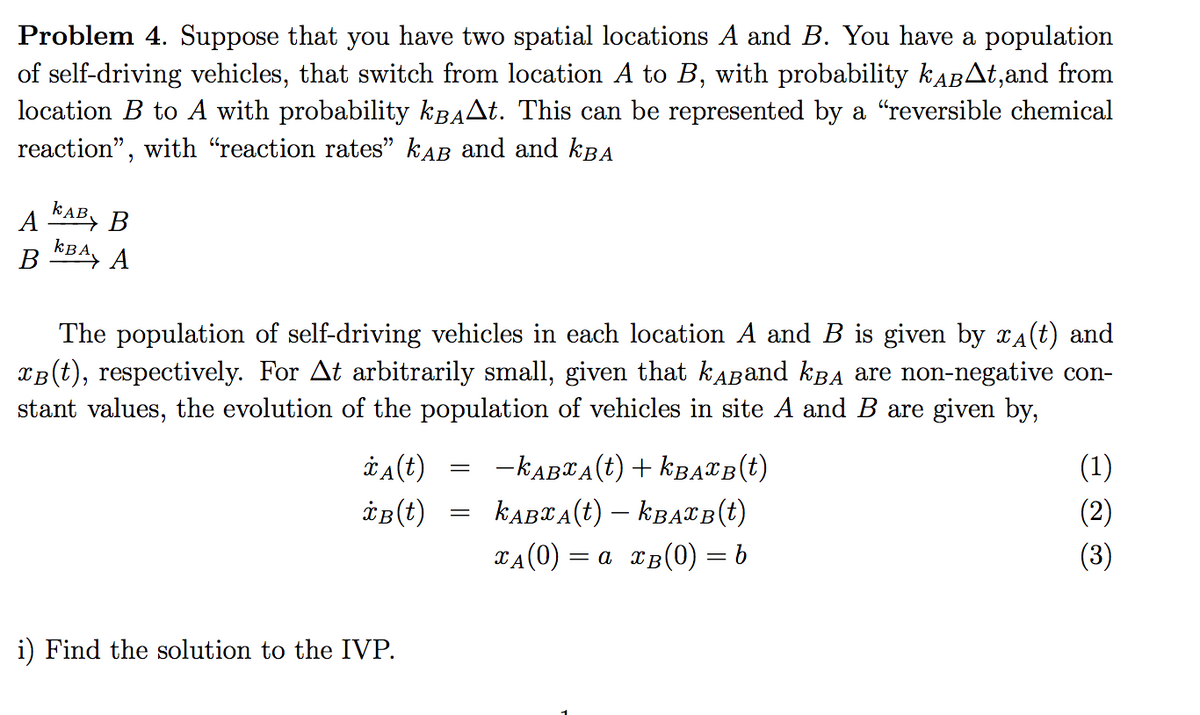Problem 4. Suppose that you have two spatial locations A and B. You have a population of self-driving vehicles, that switch from location A to B, with probability kABAt,and from location B to A with probability KBAAT. This can be represented by a "reversible chemical reaction", with “reaction rates" kAB and and kba A KAB, B B KBA, A kbA, The population of self-driving vehicles in each location A and B is given by XA(t) and XB(t), respectively. For At arbitrarily small, given that kABand kBA are non-negative con- stant values, the evolution of the population of vehicles in site A and B are given by, A(t) -KABTA(t) + KBATB(t) (1) IB(t) KABTA(t) – KBATB(t) (2) = a xB(0) = b i) Find the solution to the IVP.
Problem 4. Suppose that you have two spatial locations A and B. You have a population of self-driving vehicles, that switch from location A to B, with probability kABAt,and from location B to A with probability KBAAT. This can be represented by a "reversible chemical reaction", with “reaction rates" kAB and and kba A KAB, B B KBA, A kbA, The population of self-driving vehicles in each location A and B is given by XA(t) and XB(t), respectively. For At arbitrarily small, given that kABand kBA are non-negative con- stant values, the evolution of the population of vehicles in site A and B are given by, A(t) -KABTA(t) + KBATB(t) (1) IB(t) KABTA(t) – KBATB(t) (2) = a xB(0) = b i) Find the solution to the IVP.
Advanced Engineering Mathematics
10th Edition
ISBN:9780470458365
Author:Erwin Kreyszig
Publisher:Erwin Kreyszig
Chapter2: Second-order Linear Odes
Section: Chapter Questions
Problem 1RQ
Related questions
Question

Transcribed Image Text:Problem 4. Suppose that you have two spatial locations A and B. You have a population
of self-driving vehicles, that switch from location A to B, with probability KABAT,and from
location B to A with probability kBAAt. This can be represented by a "reversible chemical
reaction", with "reaction rates" kAB and and kBA
A KAB, B
kBA
В
The population of self-driving vehicles in each location A and B is given by XA(t) and
XB(t), respectively. For At arbitrarily small, given that kABand kba are non-negative con-
stant values, the evolution of the population of vehicles in site A and B are given by,
*a(t)
-KABTA(t) + KBATB(t)
(1)
KABTA(t) – KBATB(t)
(2)
TA(0) :
= a xB(0) = b
(3)
i) Find the solution to the IVP.
Expert Solution
This question has been solved!
Explore an expertly crafted, step-by-step solution for a thorough understanding of key concepts.
This is a popular solution!
Trending now
This is a popular solution!
Step by step
Solved in 5 steps with 5 images

Knowledge Booster
Learn more about
Need a deep-dive on the concept behind this application? Look no further. Learn more about this topic, advanced-math and related others by exploring similar questions and additional content below.Recommended textbooks for you

Advanced Engineering Mathematics
Advanced Math
ISBN:
9780470458365
Author:
Erwin Kreyszig
Publisher:
Wiley, John & Sons, Incorporated

Numerical Methods for Engineers
Advanced Math
ISBN:
9780073397924
Author:
Steven C. Chapra Dr., Raymond P. Canale
Publisher:
McGraw-Hill Education

Introductory Mathematics for Engineering Applicat…
Advanced Math
ISBN:
9781118141809
Author:
Nathan Klingbeil
Publisher:
WILEY

Advanced Engineering Mathematics
Advanced Math
ISBN:
9780470458365
Author:
Erwin Kreyszig
Publisher:
Wiley, John & Sons, Incorporated

Numerical Methods for Engineers
Advanced Math
ISBN:
9780073397924
Author:
Steven C. Chapra Dr., Raymond P. Canale
Publisher:
McGraw-Hill Education

Introductory Mathematics for Engineering Applicat…
Advanced Math
ISBN:
9781118141809
Author:
Nathan Klingbeil
Publisher:
WILEY

Mathematics For Machine Technology
Advanced Math
ISBN:
9781337798310
Author:
Peterson, John.
Publisher:
Cengage Learning,

